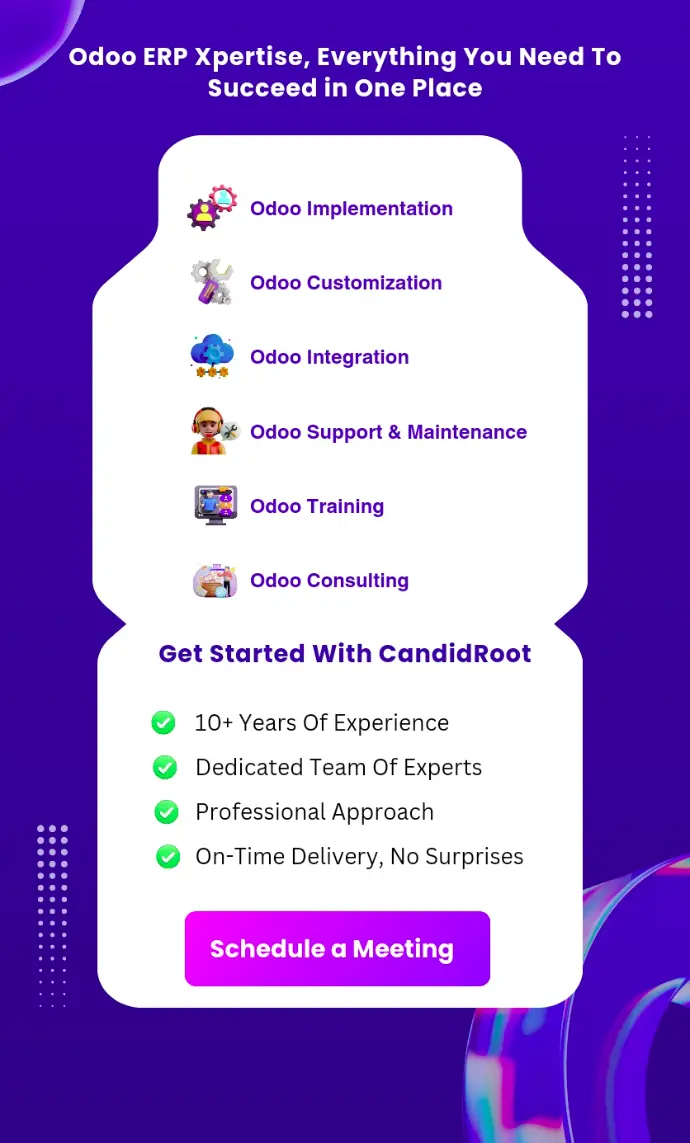Running a booming business usually entails balancing several tools, like sales in one app, stock in another, and accounts in a third. This can slow down work when information gets piled up. Odoo ERP integration helps you solve this issue by bringing all these tools together in one system, so your team can access the same information in real time and react more swiftly.
Built to work flawlessly as one system, it is a full suite of business applications, including CRM, Sales, Accounts, Inventory, POS, Projects, and others. Odoo's real strength resides in its capacity to remain simple to use while keeping every process completely integrated.
Why Business Need Odoo Integration?
When business tools fail to communicate, teams end up reentering the same data, making errors, and wasting time. This leads to losing track of orders, bills, stock, and support tasks. Odoo integration services solve this problem by running all apps on a single platform, keeping every detail updated and connected in real time.
For example, every sale in Odoo simultaneously lowers inventory and registers the transaction in accounts. You can also link Odoo to external tools like online stores, banks, shipping tools, and CRMs through built-in links or the API. This turns many processes into one clean flow.
How Odoo Helps Businesses Grow?
Growth requires clear vision and swift action. Odoo gives both:
- End-to-end view: With Odoo, managers have a full line of sight across leads, quotations, orders, stock, and bills, which helps them to address what does not function well quickly.
- Fast change: Starting modestly with Sales and Accounts, as the company expands, you may quickly incorporate Inventory, POS, or HR since every application links effortlessly on the same basis.
- Open links: The open API enables you to push and pull data using the tools you already use, therefore preserving your tech stack as lean, integrated, and prepared for scaling.
With one source of truth, you reduce waste, move quickly, and serve more clients with the same team size.
Better Customer Experience with Odoo
Satisfied clients come from clear, fast, and on-time service. Odoo helps you do that:
- Unified client record: The same customer page, where notes, emails, and orders are kept, serves the sales, support, and billing teams.
- Accurate stock and ship info: Every stock movement immediately changes both the count and the corresponding order line, enabling staff to provide precise delivery dates that develop client trust.
- Smooth support: Because Helpdesk and CRM share data, agents can see past orders at a glance and resolve issues quickly.
- Self-serve tools: Customers can monitor their own orders and invoices without waiting for your team by connecting your website and portal to Odoo.
These features turn one-time buyers into long-term customers.
How Odoo Improves Productivity?
Odoo reduces extra steps and manual effort:
- No double entry: Enter data once and watch it flow to Sales, Inventory, and Accounts.
- Simple workflows: Triggers move tasks one stage to the next, for example, quote to order, order to pick, pick to bill, without copy-paste.
- Clear dashboards: Teams get live KPIs and can filter, group, and export in a few clicks to act on facts.
- HR in sync: Staff, attendance, and payroll run in one system, which keeps records clean and minimizes admin work. When routine tasks are handled automatically, your team can focus on sales, service, and new ideas, thus increasing productivity.
Why You Need an Odoo Integration Service?
You can link apps on your own, but a skilled Odoo developer team can save time and avoid rework. A good partner will do the following aspects for your business.
- Map your flows: They learn how you sell, buy, ship, and bill, then draft the right links.
- Pick the right method: Built-in link, API call, file sync, or a small custom app, and each case has a best fit.
- Set rules and tests: They handle error cases, sync timing, and data checks so your links stay stable.
- Train your staff: Clear steps and good docs make hand-offs easy and keep teams in sync.
- Support and optimization: As you grow, they add apps, fields, and checks without breaking what works.
This is where Odoo integration services stand out, reducing risk, speeding up implementation, and keeping data clean and safe.
Real-World Example
A D2C brand combines store, stock, and accounts
A small home-based brand sells on its online store and in a city store. Before Odoo, they used separate apps for the site, stock, and bills, which led to late orders, incorrect stock counts, and slow refunds.
What Changed with Odoo:
- Web store link: Orders from the site drop into Odoo Sales at once.
- Pick and shipment flow: The warehouse sees new picks in Odoo, prints labels, and ships with an integrated carrier tool.
- Auto posting: Each paid order posts to accounts with the right taxes and fees. Bank synchronization clears the payment match.
- Support view: They help the team see the full order trail so that they can process refunds or exchanges in minutes.
Final Thoughts
Odoo integrates sales, stock, accounts, projects, and HR into a single system, and hence your staff works with clean data and explicit duties. Whether designed natively or coupled through the API, smart links transform slow, manual processes into smooth, automated flows.
Begin by connecting your basic flows, orders, stock, and bills if your technological setup is unclear. As you increase links during development, you will progressively notice less waste, quicker cycles, and more content customers. That's the real benefit of Odoo ERP integration correctly applied.


